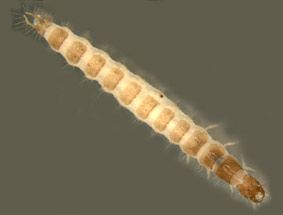Descriptive Features:
Adults
antennae largely pubescent
dorsal surfaces with well-developed, erect, sensory setae at fixed positions
prothorax with pair of notopleural sutures (distinct from sharp lateral margins) separating notum from externally visible pleuron on each side
abdomen with ventrite 1 divided into 2 or 3 parts by hind coxae
mesocoxal cavities distinctly closed laterally by meeting of mesosternum and metasternum
metacoxae not extending laterally to meet elytra, so that junction of metepimeron and 1st ventrite is usually visible
fore tibia notched, forming antenna cleaner
tarsi always 5-segmented
size:
Larvae
labrum completely fused to head capsule
abdominal tergum 8 usually subterminal
abdominal tergum 9 bearing pair of well developed urogomphi
legs 6-segmented, including claws
size: up to 10mm |

|
Carabidae larva |
|
|
Ecology: Commonly known as 'ground beetles', Carabidae species can be divided into 3 ecological groups; Geophiles = animals that live in the ground, not associated with water; Arboricoles = animals that live above ground, associated with tree trunks, leaves and logs; Hydrophiles = animals that live in riparian zones, associated with water bodies including salt lakes. Hydrophiles are of interest to this guide and include the subfamilies Apotominae, Brachininae, Bembidiinae, Chlaeniinae, Cicindelinae, Pterostichitaeinae, Oodinae, Odacanthinae, Pogoninae, Scaritinae, and Trechinae. There is little specific information on Australian species.
Instream habitat: The hydrophilic carabid beetles live in damp habitats at the edge of water bodies or swamps, with a minute species of Bembidiinae known to be interstitial i.e. dwelling in the intersitial spaces of the substratum. Some larvae are found on vegetation while others burrow into the bank or rotting woody debris e.g. snags. Tasmanotrechus species are found in caves.
Feeding ecology: Carabid larvae are predators, feeding on soft-bodied insects, snails and worms. Carabid adults are generally terrestrial predators but several species may be found foraging under water searching for snails, crustaceans, insect larvae, tadpoles, and small fish. Most are nocturnal hunters or scavengers, sheltering in the daytime.
Habit: Adults are wing-dimorphic (or polymorphic). Many species are flightless with the elytra almost permanently bonded. A few species have retained hind wings and only some individuals can fly to disperse to new habitats when the water bodies where they dwell dry out. Adults of all species defend against predators by discharging repellent secretions through orifices on either side of the anus.
Life history: There is no specific information on Australian semi-aquatic species. However, in Australia and overseas, cases of maternal care for caches of eggs or young larvae have been recorded for some species of Pterostichinae. |
Information Sources: Baehr 2012, Grebennikov 2008, Lawrence 1992, Lawrence & Britton 1991, Walton 1987, Hawking & Smith 1997, Williams 1980, Baehr 2005, 2001, 1990, 1990a, 1987, Hudson 1994, Giachino 2005, Toledano 2005, Giachino 2003, Mathews 1980
Key to Subfamilies and Tribes: Lawrence & Britton 1994, 1991 (adults inc. terrestrial)
Key to Genera: Baehr 2009a refers to Baehr 2005 (Odacanthinae adults)
Will & Kavanaugh 2012 (Pterostichitinae adults extract from PNG))
Grebennikov 2008 (Trechinae larvae, world, incomplete)
Key to Species: Baehr 1990a (Apotominae: Apotomus adults)
Toledano 2005 (Bembidiinae: Bembidion adults)
Baehr 2012 (Brachininae: Pheropsophus adults)
Baehr 2009a refers to Baehr 2005, 2006 (adults) (Odacanthinae:Dicraspeda, Eudalia adults)
Baehr 2005 (Odacanthinae adults)
Baehr 2010 refers to Hudson 2000 (adults) (Pogoninae: Pogonus adults, inc. salt))
Giachino 2005 (Pterostichitinae: Catadromus adults)
Baehr 2008a, 2008b, 2009b (Trechinae: Tasmanitachoides adults)
Moore 1994 (Trechinae: Tasmanotrechus adults)
Baehr 1987 (Trechinae: Perileptus adults) |